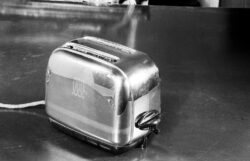Toastmaker was redesigned by the Waters-Genter Company in 1926 (Picture: Getty Images)
Without a doubt, kitchen gadgets have made our life very easy, from grinders to microwaves to air fryers: it’s easy to get tasty food on our plates quickly.
As we look to save money on energy bills and the weekly shop, our minds turn to certain kitchen appliances and what ones might cost the most to run.
One such appliance many simply couldn’t live without though – particularly on a Sunday morning – is the humble toaster.
However, have you ever wondered about who invented one of the most-usable gadgets for a hearty cooked breakfast?
Let’s talk about the innovator in detail who made such an effortless creation for humans:
Who invented the toaster and when?
Toasting bread dates back thousands of years and was originally devised as a method to keep bread from going mouldy.
The art of toasting can be traced back to Roman Times when slices of bread were toasted by using a long metal fork or in a metal frame held over a fire, or on a gas stove until it was browned.
Evidence of toasting has been found even further back in history among other cultures including the Egyptians, the Saxons, Huns and other tribes.
The initial first few high-resistant toasters were made up of wires and Nichrome composite (Picture: Getty Images)
But the toaster as we know it today didn’t come to life until the early 1900s, when Albert Marsh created a high-resistance nickel and chromium composite called ‘Nichrome’ which was safe and durable to use as it could be heated/cooled many times, unlike light bulb filament.
During this period, many other inventors used Nichrome to produce a heat-resistant electric toaster.
The first successful version was innovated by Frank Shailor of General Electric in 1909 through his ‘D-12’ model that consisted of a competing alloy.
It’s touted as the first commercially successful electric toaster, however, it could only toast one side of the bread at a time, and bread had to be flipped to be toasted on both sides.
Across the early 20th century, households had a limited supply of electricity, especially during the daytime, which meant these toasters were many used in restaurants.
Westinghouse soon came up with its own version of a toaster in 1914, while the Copeman Electric Stove Company added an ‘automatic bread turner’ to its toaster in 1915.
When was the first pop-up toaster invented?
Many inventors came with their own versions of toaster (Picture: Getty Images)
Charles Strite, a Minnesota mechanic created the first pop-up toaster in 1919, and he received his patent for the automatic pop-up toaster in 1921.
The specifications of the toaster included a metal closed case to protect hands from the heating rods while incorporating a set-timer to shut off once reached the maximum heating temperature that further released the toasted bread with the help of a pop-up spring.
Later, the Waters-Genter Company redesigned Strite’s toaster – ‘Toastmaker’ in 1926 which was a huge success.
The advertisements promoted the ‘toast maker’ as the ‘perfect toast every time—without watching, without turning, without burning.’
More: Trending
Carrying forward to today, it is interesting to see how far the innovations of the toaster have come after its first-ever big breakthrough in the 20th century.
Toasters being the most common household appliance have gone through different versions from heat-resistant plastic toasters to rounded sides in a plethora of colours.
Some offered wider slots to toast bagels, thick slices, and pita bread, while other models had six slots for multiple toasting.
By the 21st century, toasters have evolved to include such gimmicks as personal messages and even combination toasters/oven/broilers that can both toast bread and bake a coffee cake. Delicious!
MORE : Woman shares four-ingredient air fryer banana bread recipe
MORE : Devastating price rises of everyday foods including pasta, chips and bread
Follow Metro across our social channels, on Facebook, Twitter and Instagram
Share your views in the comments below
Whoever made the toaster deserves our thanks.





